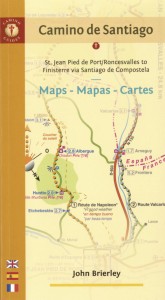Walking to the End of the Earth
 It’s been said that a journey of a thousand miles begins with a single step. In my case, the journey of 500 miles (the Camino de Santiago) begins with a stack of books.
It’s been said that a journey of a thousand miles begins with a single step. In my case, the journey of 500 miles (the Camino de Santiago) begins with a stack of books.
This one, by John Brierley, is a set of 36 maps broken up into day-long walks, each between 12 and 20 miles long, starting at St. Jean Pied de Port (in the southeast corner of France) and ending at the Atlantic Ocean, on the western-most edge of Spain, in a town called Finisterre (trans: End of the Earth).
The Camino actually ends at Santiago de Compostela (trans: St. James of the Field of Stars), at the Cathedral where James, the Apostle, is said to be buried, but many people….myself included….plan to continue walking on to Finisterre (about 35 miles farther), which seems a more poetic destination.
I love the idea of walking to the end of the earth.
Especially by way of the Camino, which itself is a kind of poem. And which seems to evoke the poetic, whenever anyone talks about it. Even in this book of maps, for example. Here’s an excerpt from the introduction:
“We all have too much paraphernalia in our lives. In an effort to lighten the load, we have produced this slim lightweight volume of basic maps….
“All of us travel two paths simultaneously — the outer path along which we haul our body and the inner pathway of soul. We need to be mindful of both and take time to prepare ourselves accordingly. The traditional way of the pilgrim is to travel alone, by foot, carrying all the material possessions we might need for the journey ahead. This provides the first lesson of the pilgrim — to leave behind all that is superfluous and to travel with only the barest necessities.
“Preparation for the inner path is similar — we need to start by letting go of psychic waste accumulated over the years such as resentments, prejudice and outmoded belief systems. With an emptied mind we will more readily assimilate the lessons that come our way…”
Buen Camino.
